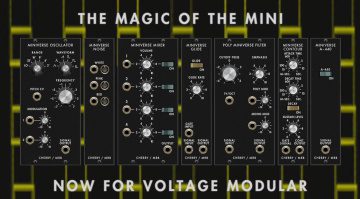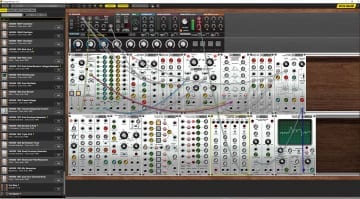Cherry Audio imports the 900-Series Moog modules into Voltage Modular
The VM900 collection is Cherry Audio’s attempt to capture the magic of the Moog 900-series modular synthesizer in software form. It’s looking pretty epic.
The VM900 series consists of 27 modules designed in collaboration with Mark Barton of MRB. They are going for “spine-tingly accuracy” with every “sonic nuance exactingly recreated”. If any of Cherry Audio’s recent work is anything to go by then these should be superb.
Moog 900-series
So, what is the 900 series? These were the basis of Moogs first modular systems released in the late 1960s. They were almost entirely designed by Bob Moog and built to be musician friendly with basic concepts, jack inputs and outputs and good labelling.
The tuning of the system was notoriously wobbly which also added to its character although Moog did come up with more stable 921 VCOs later on. It also gave birth to the 904A 23 dB/Oct lowpass ladder filter. While the majority of modules functioned as what we would generally call a traditional synth voice of oscillators, envelopes, VCAs, filters and mixer there were also some more esoteric ideas in there like the Frequency Shifter, Sample & Hold and Random Signal Generator.
VM900
Cherry Audio has taken on the whole lot, or at least the most commonly produced ones including the updated 921-series oscillators. The oscillator drift has been emulated, the mixer overdrive reproduced and the front panels have been replicated as accurately as possible. Cherry Audio has also put together some combos like the 921ABBB Oscillators and the 904BCA Filters. What is not mentioned is how the issue of S-Trig and V-Trig has been tackled in the context of Voltage Modular which is based on Eurorack formats. There’s no S-Trig to V-Trig conversion module and while an “S” input exists on the VCOs it’s not described in the manual. The envelopes appear to have lost the S-Trig input and instead have a “Gate” input. I guess we can assume that Cherry Audio has quietly done away with the confusion that S-Trig could cause with the users. It probably doesn’t matter but I would have liked it to be talked about!
You are currently viewing a placeholder content from YouTube. To access the actual content, click the button below. Please note that doing so will share data with third-party providers.
Anyway, we get all the expected modules including the 960 Sequential Controller sequencer to which is added a quantized output just to make things a little easier. Cherry Audio has come up with a MIDI interface module to make it easier to adapt the system to a keyboard input. You’ll even find a couple of blank panels so that you can make your VM900 series cabinets look nice and even.
You can download the free version of Voltage Modular and try out the VM900 series for free for 7 days. It comes with a whole host of presets that take you on a bit of journey through both the familiar and the bizarre. While it can get complex and baffling it does sound magnificent.
Available now
The VM900 collection for Voltage Modular is available for $79 for macOS and Windows.
More information from Cherry Audio
3 responses to “Cherry Audio imports the 900-Series Moog modules into Voltage Modular”









love the voltage modular stuff – thanks for sharing your thoughts!
I wonder how this compares to Arturia’s Modular V. I guess the big difference is that by being part of Voltage Modular, it’s a true modular as opposed to Arturia’s semi-modular setup.
good call – without having used the V Collection instrument, for anyone trying to figure out what this means, in Voltage Modular, if you want 5 oscillators, or 73 oscillators, or 12 sequencers, you can have them – you’re only limited by what your CPU can handle